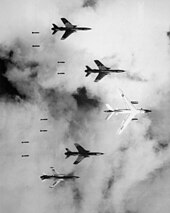
High level bombing (also called high-altitude bombing) is a tactic of dropping bombs from bomber aircraft in level flight at high altitude. The term is used in contrast to both World War II-era dive bombing[2] and medium or low level bombing.
Prior to the modern age of precision-guided munitions (PGMs), high level bombing was primarily used for strategic bombing—inflicting mass damage on the enemy's economy and population—not for attacks on specific military targets. High level bombing missions have been flown by many different types of aircraft, including medium bombers, heavy bombers, strategic bombers and fighter-bombers.
The choice to use high level bombing as an offensive tactic of aerial warfare is dependent not only upon the inherent accuracy and effectiveness of the bombing aircraft and their delivered ordnance on the target, but also upon a target's air defense capabilities. From the 1940s onward, radar in particular became a powerful new defensive early warning tool, and a serious threat to attacking aircraft when they flew at higher altitudes towards their target.
Bombing from medium to high altitudes, especially in the post-World War II era with sophisticated surface-to-air missiles, interceptor aircraft and radars exposes attacking bomber aircraft to greater risks of detection, interception and destruction. During World War II, various methods were employed to protect high level bombers from flak, fighter aircraft and radar detection, including defensive armament, escort fighters, chaff and electronic jamming. Modern stealth aircraft technologies, for example, can alleviate some risks inherent to high level bombing missions, but are not a guarantee of success or permanent solution for the attackers.
- ^ Jacob Van Staaveren, "Gradual Failure: The Air War over North Vietnam: 1965–1966" (Washington, D.C.: Air Force History and Museums Program, 2002), p 226–227.
- ^ "The Bomber War" by Robin Neillands, ISBN 0-7195-5637-6, p.35